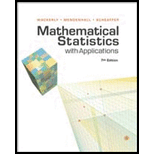
Concept explainers
If Y1 is the total time between a customer’s arrival in the store and departure from the service window and if Y2 is the time spent in line before reaching the window, the joint density of these variables was given in Exercise 5.15 to be
The random variable Y1 − Y2 represents the time spent at the service window. Find E(Y1 − Y2) and V(Y1 − Y2). Is it highly likely that a randomly selected customer would spend more than 4 minutes at the service window?
5.15 The management at a fast-food outlet is interested in the joint behavior of the random variables Y1, defined as the total time between a customer’s arrival at the store and departure from the service window, and Y2, the time a customer waits in line before reaching the service window. Because Y1 includes the time a customer waits in line, we must have Y1 ≥ Y2. The relative frequency distribution of observed values of Y1 and Y2 can be modeled by the
with time measured in minutes. Find
- a P(Y1 < 2, Y2 > 1).
- b P(Y1 ≥ 2Y2).
- c P(Y1 − Y2 ≥ 1). (Notice that Y1 − Y2 denotes the time spent at the service window.)
Trending nowThis is a popular solution!

Chapter 5 Solutions
Mathematical Statistics with Applications
 Linear Algebra: A Modern IntroductionAlgebraISBN:9781285463247Author:David PoolePublisher:Cengage Learning
Linear Algebra: A Modern IntroductionAlgebraISBN:9781285463247Author:David PoolePublisher:Cengage Learning
